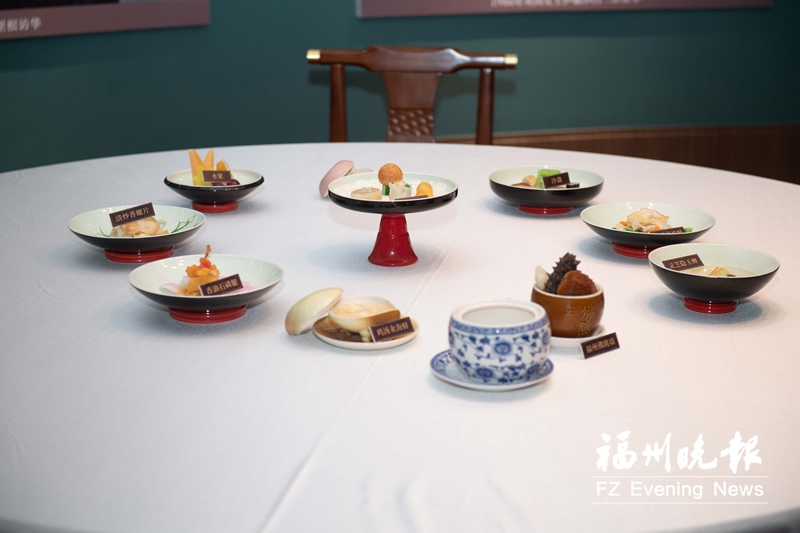China Fujian Cuisine Culture Museum: Collections of “Delicacies from Mountains and Seas”
Fujian, situated beside mountains and seas, has a long coastline, which brings a rich supply of seafood all year round. The lush mountains boast numerous green bamboos, as well as tea, mushrooms, bamboo shoots and chestnuts with fragrance spreading afar. Fujian's unique natural resources lay a reliable material foundation for the prosperity of Fujian cuisine. Let's have a good look at the “delicacies from mountains and seas” at the Fujian Cuisine Culture Museum.
The exhibition area of vegetarian dishes gathered the molds of various dishes. In terms of cooking methods, the vegetarian dishes of Fujian cuisine can be divided into quasi-meat vegetable dishes and vegan dishes. A quasi-meat vegetable dish is named after the meat, cooked into meat patterns, and flavored with meat. The vegetarian dishes of the Yongquan Temple in Mount Gu are the representatives, including the “Sauteed Sliced Abalone in Rice Wine Sauce”. A vegan dish has no meat in its name, and isn’t cooked into meat patterns or flavored with meat. The vegan dishes of the South Putuo Temple in Xiamen are the representatives.

A display of state banquet dishes.
When you enter the hall, in the exhibition area of “A Long History of Fujian Cuisine”, what comes into view are the dish molds derived from mountains and seas: perch, razor shell and abalone... “Due to the different terrains and climates between the coastal areas and the mountain areas, Fujian cuisine can be divided into 'mountain cuisine’ and 'sea cuisine’,” the narrator told the reporter. The “mountain cuisine” is prevalent in northern and western Fujian. The ingredients are mainly mountain products, poultry and livestock. The “sea cuisine” is common in eastern Fujian and southern Fujian. The ingredients are mainly seafood and river fresh.
On the second floor, in the exhibition area of “Traditional Fujian Food”, a display wall of Fujian cuisine makes your mouth watery. They are plates of delicate Fujian cuisine dish molds. Next to the display wall, the big electronic screen brings an interactive experience to visitors. The “bubble” icons of 156 classic Fujian cuisines, represented by Fuzhou cuisines, were scrolled in turns on the big screen. With a click of any “bubble”, visitors could view the ingredients and cooking technique of the corresponding dish.
The exhibition area of vegetarian dishes gathered the molds of various dishes. In terms of cooking methods, the vegetarian dishes of Fujian cuisine can be divided into quasi-meat vegetable dishes and vegan dishes. A quasi-meat vegetable dish is named after the meat, cooked into meat patterns, and flavored with meat. The vegetarian dishes of the Yongquan Temple in Mount Gu are the representatives, including the “Sauteed Sliced Abalone in Rice Wine Sauce”. A vegan dish has no meat in its name, and isn't cooked into meat patterns or flavored with meat. The vegan dishes of the South Putuo Temple in Xiamen are the representatives.
Since ancient times, hosting banquets for guests has been an etiquette in society. In the development of Fujian cuisine, all banquets, from state banquets and Man-Han banquets to local fetes and traditional feasts, manifest diverse folk customs in Fujian.
Since the 1970s, Fujian cuisine has been selected into state banquets many times, and has become a name card for Chinese catering culture. In 1984, Qiang Mugen, Qiang Ququ and other Fujian cuisine chefs took charge and prepared the banquet for receiving President Reagan of the US. The team worked out the menu within one day, which got approved without question and became the first menu “approved in one draft” in the state banquet history. The Scene Display Area restores the state banquet on that day. On the table are arranged a variety of dish molds: Braised Sea Clam with Chicken Soup, Juchunyuan Fotiaoqiang of Fuzhou, Bullfrog Legs Fried in Sesame Oil, etc.
Address: Zone 6, Fuzhou Cross-Straits Olympic Sports Center Commercial Plaza, Fuwan Road, Cangshan District, Fuzhou City.